Ram Power Wagon lives up to lofty image
By John Gilbert
All right, we’ve established a few ground rules for large pickup truck wars, which have escalated to the point where the full-size trucks are so huge, the new breed of midsize trucks seems more than large enough. But if we did have to have a monster truck truck-off, so to speak, what would we pick to win?
That’s pretty impossible to say, because truck wars have such indelibly inscribed sets of favorites you’re sure to offend somebody when you pick something different. More likely, everybody makes their contribution.
Having previously reported on the Ford monster dualie F350, it’s hard to find anything bigger or bossier. The F250 Super Duty, meanwhile, is a monster that could be a candidate for king of the reasonably-sized monster trucks. And Ford’s Raptor is a specially built performance king for serious off-road duty with an ultra-macho on-road presence.
None of that prepares us for today’s topic, however. Which would be Dodge. Now Dodge, for example, gets no choice any more because Dodge trucks are no longer Dodge trucks; they are Rams. We will accept as a valid candidate the newest and most monster-like Ram of them all, the “Ram 2500 Power Wagon Crew Cab 4X4.” Got all that?
If a Power Wagon needs power, how about a 6.4-liter Hemi V8? This is the basic engine that powers the Hellcat Charger and Challenger models, with 707 tire-screeching horsepower, only this one is normally aspirated, and it is beefed up for heavy-duty trucking.
If you’re taking a group to see, for example, a Monster Truck competition, the Ram Power Wagon would be the ideal conveyance.
The heavy-duty grille rollbars add to the impression that you’re ready for some heavy use. And imbedded horizontally into the front bumper is a small cable with a little tag on the end. It is a 12,000 pound winch. Pull the tab and it uncoils. I figure you could use this thing to drive along after a blizzard and pull your neighbor’s semi out of a ditch, if necessary.
This monster is, indeed, a monster, and it even has a feature or two that puts it onto a higher monster plateau than the huge Fords. It is a “bad”-looking truck, in the manner of current vernacular where “bad” means “real good,” or, as humans used to say, “cool.” Only the Ford Raptor rivals the visual impact of the Power Wagon.
This baby is cool, and if you didn’t know it, you could read it in the vertical lettering on the front edge of the pickup bed, where it says Power and Wagon, side by side. Trouble is, looking from the driver’s side, the word Wagon is first, so it’s a “Power Wagon” from the right side, and a “Wagon Power” from the driver’s side.
We don’t care, though, because once we’re driving, we know we’re kings of the road. The occupant of the passenger bucket, and a couple of friends who rode with us in the rear, agreed with me that as rugged as the Power Wagon looks and sounds, it rides like a limousine, or a luxury sedan. Comfortable and supportive bucket seats are a big reason, and the fact they’re leather and fully adjustable helps, too.
Automatic high beams, LED interior lighting, rain-sensing wipers, satellite radio, remote start, front and rear parking alerts, an 8.4-inch touch-screen display, a 9-speaker with subwoofer audio system, and tire-pressure monitoring device all add to the creature comforts.
The tire-pressure monitoring device was an adversary for a while. Despite the winter scheduled on the calendar, we had unseasonably warm weather this winter. Enough to melt the snow, in fact, including the glacial deposit in my driveway. In a way, I was disappointed.
Here I had a vehicle perfectly suited to the most ferocious weather anyone could imagine, and it was mid-40s in Duluth in February! When it dropped to cold overnight, though, it seemed to confound the enormous all-terrain tires, and therefore the air-pressure device.
Severe cold drops tire pressure, and when you drive a while, the temperature comes up and all is well. One morning I had a light flashing, indicating a tire-pressure problem. It said I had a tire that was down on pressure, so I racked over the switch until I brought up the instrument reading that said the four tires were 56, 60, 62, and 62, with the 56 and 60 up front. My first thought was that a prescribed 50 pounds of air-pressure was surprisingly hard, but the instrument added that it would like me to inflate the tires to at least 60 pounds.
The previous day, I considered the Power Wagon’s on-road suspension to ride somewhat like a pogo stick, feeling every road irregularity and sending the big truck hopping along. So I figured going down under 60 might not be too bad.
The truck and the weather accommodated me, because a day or two later the dash instrument read 56, 56, 58, and 58. And it rode right nice. So I didn’t bother adding air, and learned to live with the nagging warning light.
If being the biggest and baddest truck in the neighborhood is important, the Power Wagon has a couple of advantages where perception becomes fact.
For example, the Ford Super Duty trucks are very large, and they would be very difficult to climb into if they didn’t have a very useful accessory — running boards. Yes, those old-time goodies of pickup trucks from a couple generations ago, simple slabs that lay there and wait to offer occupants a halfway-up step into or out of their trucks. The Ram 2500 Power Wagon Crew Cab 4X4 has no such finery.
The Power Wagon goes back to World War II, in genesis, when it was a rugged truck capable of taking on any terrain and getting through. So the newest incarnation of the Power Wagon has to start out being an off-road conqueror. And it is. That means no running boards, friend, and you either are a track star — high jump or pole vault preferably — or an exercise champion who has mastered yoga and all things flexible.
When I approached the beautiful Granite Crystal Metallic Clear Coat Ram for the first time, I opened the driver’s door and…pondered the possibilities. The floor of the front seat was about waist-high, and the seats themselves were ‘way up there. There was a grab handle on the A-pillar, which is that pillar that secures the windshield to the door frame.
Quite gingerly — because I have had a right-side hip replacement — I swung my right leg up as high as I could, and, fortunately, that was good enough for my heel to catch the floor. With that, I grabbed the grab handle, but I learned you have to grab it with your left hand, because your right hand doesn’t give your body enough of an ergonomic mechanical advantage to make it the rest of the way.
So I grabbed with my left hand and did a modified jump step with my left foot from good ol‘ terra firma. With that, I yanked on the grab handle and got the right half of my rear end onto the near edge of the bucket seat. From there, it was a simple slide step to get over the rest of the way.
Getting out, on the other hand, required the kind of bravery you had to have the first time you went down any ski hill larger than bunny size. It seems foolhardy, but here goes, and without a parachute.
Of course, the going is what makes the Power Wagon a treat. The 6-speed automatic transmission responds well, especially when you might hammer the gas pedal a bit. The hefty Power Wagon launches like a jet fighter leaving an aircraft carrier, shifting hard but meaningfully smooth as you swiftly get up to freeway speed.
Externally, the Power Wagon has articulating suspension, and skid plate shields for the fuel tank, transfer case, and any other items that might not take a jolt. A front disconnecting stabilizer bar, manual shift-on-the-fly transfer case, a 4.10 rear axle ratio, trailer brake control, and hill-descent control all augment the normal stability control and antilock brakes.
A rear bed with adjustable anchors and a tonneau cover ride between the special Ram cargo management system, which indicates those lockable, flip-open top ridges on the bed walls. Combining all the assets of real ruggedness as well as the illusion of ruggedness, plus the special graphics and convenience features of an ultra-modern and high-tech truck, make the as-tested sticker of $62,610 seem, well, reasonable.
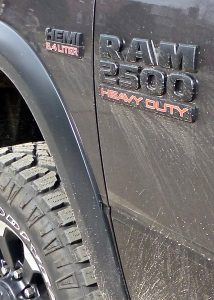
If the sheer size and demeanor of the Power Wagon don’t do the job, assorted badges and graphics will.
Base price for the Power Wagon is $51,695.
If your neighbors don’t believe your Power Wagon is the new king of the hill, simply hammer the throttle as you zoom past their house, or SUV, sounding like a NASCAR race car. And if they still don’t believe it, stop and ask them to hop in.
By the way, a fellow who knows better unflinchingly brought an extra tool for a ride in the Ram 2500 Power Wagon, He had an empty crate, the kind you might haul six half-gallons of stuff in, and he hooked a very neat straightened hanger to it, then he set it next to the opened door and climbed onto it, stepping quite easily inside, after which he reached down to grasp the wire, and lifted the crate inside.
Very neat idea. Once inside, you’re laughing; getting there is the project.


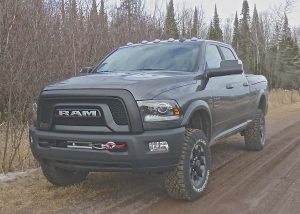
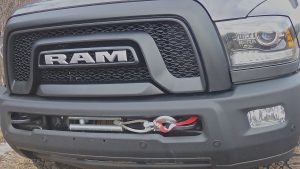
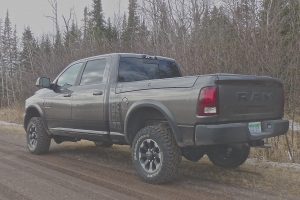
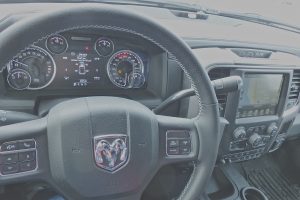
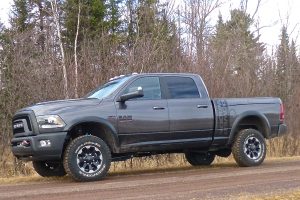
 John Gilbert is a lifetime Minnesotan and career journalist, specializing in cars and sports during and since spending 30 years at the Minneapolis Tribune, now the Star Tribune. More recently, he has continued translating the high-tech world of autos and sharing his passionate insights as a freelance writer/photographer/broadcaster. A member of the prestigious North American Car and Truck of the Year jury since 1993. John can be heard Monday-Friday from 9-11am on 610 KDAL(www.kdal610.com) on the "John Gilbert Show," and writes a column in the Duluth Reader.
John Gilbert is a lifetime Minnesotan and career journalist, specializing in cars and sports during and since spending 30 years at the Minneapolis Tribune, now the Star Tribune. More recently, he has continued translating the high-tech world of autos and sharing his passionate insights as a freelance writer/photographer/broadcaster. A member of the prestigious North American Car and Truck of the Year jury since 1993. John can be heard Monday-Friday from 9-11am on 610 KDAL(www.kdal610.com) on the "John Gilbert Show," and writes a column in the Duluth Reader.